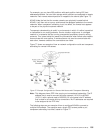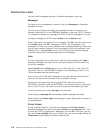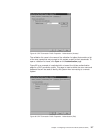
Table 8. Comparison of communication services and relative costs (continued)
Service Line Speed
Required
Equipment
DTE/DCE
Interface
Relative Cost
(per month)
ISDN switched
56, 64, 112, or
128Kbps
ISDN terminal
adapter
RS232
asynchronous
$50-$250
Fractional T1
56Kbps to
1.544Mbps
CSU/DSU or T1
mux
X.21/V.35/RS449
synchronous
$100-$2,000
T1/E1
56Kbps to
1.544/2.048
Mbps
CSU/DSU or T1
mux
X.21/V.35/RS449
synchronous
$350-$2,000
Analog Phone Lines
The analog connection, which uses modems to carry data over leased or switched
lines, sits at the bottom of the point-to-point scale. Leased lines are full-time
connections between two specified locations, while switched lines are regular
voice-phone lines.
The fastest modems today operate at an uncompressed rate of 33.6Kbps. Given
the signal-to-noise ratio on unconditioned voice-grade telephone circuits, though,
this rate is often unattainable. Modem manufacture claims of higher bit-per-second
(bps) rates are usually based on a data compression (CCITT V.42bis) algorithm that
is utilized by their modems.
Although V.42bis has the potential to achieve as much as four-fold reduction in data
volume, compression depends on the data and rarely reaches even 50%. Data
already compressed or encrypted may even increase with V.42bis applied.
Emerging technology referred to as X2 or 56Flex extends the bps rate to 56k for
analog telephone lines. This is a hybrid technology that requires one end of the
PPP link to be digital while the opposite end is analog. Additionally, the 56Kbps
applies only when you are moving data from the digital toward the analog end of
the link. This technology is well suited for connections to ISPs with the digital end of
the link and hardware at their location.
Typically, you can connect to a V.24 analog modem over an RS232 serial interface
with an asynchronous protocol at rates up to 115.2Kbps.
Digital Data Service
With digital, data travels all the way from the sender’s computer to the central office
of the telephone company, to the long distance provider, to the central office, and
then to the computer of the receiver in digital form. Digital signaling offers much
more bandwidth and higher reliability than analog signaling. A digital signaling
system eliminates many of the problems that analog modems must deal with, such
as noise, variable line quality, and signal attenuation.
DDS
The most basic of digital services is called Digital Data Services (DDS). DDS links
are leased, permanent connections, running at fixed rates of up to 56Kbps. This
service is also commonly designated as DS0.
112 OS/400 TCP/IP Configuration and Reference V4R4


















